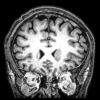i think the alpha 7 receptor is activating other pathways, dopamine and serotonin. that helps explain why nicotine withdrawal makes anxiety disorder (methinks even non-ADD anxiety) 10x worse.
Transdermal Nicotine in Adult ADHD With Depression and Anxiety
James A. Cocores, M.D. (2008)
Sir: Focusing and memory ability are dysfunctional in attention-deficit/hyperactivity disorder (ADHD),1 which commonly co-occurs with depression and anxiety.2 Treatment with methyl-phenidate or amphetamine frequently corrects inattentiveness and memory impairment, but is less reliable in the alleviation of the accompanying depression and anxiety. These medicines have depression and anxiety as reported side effects. In addition to the involvement of dopaminergic and noradrenergic neurons, there is evidence to suggest that cholinergic neurons are involved in the biobehavior associated with ADHD.3
Nicotine-dependent individuals experience more inattentiveness, forgetfulness, depression, and anxiety during withdrawal, and nicotine replacement is thought to reverse withdrawal-induced focusing and memory impairment,4 depression,5 and anxiety.6 Changes in focus and memory ability, associated with nicotine dependence and replacement treatment, are directly mediated by nicotinic-cholinergic neurons, and depression and anxiety are thought to be indirectly mediated by pathways between nicotinic-cholinergic receptors and dopaminergic, nor-adrenergic, serotonergic, and gabaminergic neurons.7
The following report illustrates a case of adult ADHD associated with depression and anxiety that responded to transdermal nicotine patches.
Alpha 7 nicotinic receptor subunit is present on serotonin neurons projecting to hippocampus and septum.
Aznar S1, Kostova V, Christiansen SH, Knudsen GM. (2005)
The serotonergic transmitter system regulates hippocampal activity through its raphe projection to hippocampus and medial septum/diagonal band of Broca complex (MS/DBB), and most likely also indirectly through its interaction with the cholinergic neurotransmitter system. Nicotine, e.g., enhances hippocampal serotonin release probably through presynaptic nicotinic receptors. We investigated the possible presence of the alpha 7-nicotinic subunit on serotonergic neurons projecting to hippocampus and MS/DBB. By retrograde neuronal tracing, hippocampal serotonergic neurons were identified and with double fluorescence immunostaining and Alexa-488 bound alpha-bungarotoxin the presence of active alpha 7 receptor on their soma was determined. Most of the retrogradely labeled serotonin neurons contained the alpha 7 subunit. A low degree of colocalization between alpha-bungarotoxin and serotonin-positive neurons suggest that the alpha 7 subunit may be transported anterogradely to the serotonergic axonal terminals.
Involvement of alpha 7 nicotinic acetylcholine receptors in gene expression of dopamine biosynthetic enzymes in rat brain.
Serova L1, Sabban EL. (2002)
Brain dopaminergic systems are critical in mediating the physiological responses to nicotine. The effects of several concentrations of nicotine (0.08, 0.17, or 0.33 mg/kg body weight) and involvement of alpha7 nicotinic acetylcholine receptors (nAChRs) in gene expression of key enzymes in dopamine biosynthesis were evaluated in the ventral tegmental area (VTA) and substantia nigra (SN), cell bodies of the mesocorticolimbic and nigrostriatal pathways. Nicotine elicited a dose-dependent elevation of mRNA for tyrosine hydroxylase (TH), the rate-limiting enzyme in dopamine biosynthesis in VTA and SN. The VTA was more sensitive to lower concentrations of nicotine with maximal response observed with the lowest dose of nicotine. Nicotine also elevated mRNA levels of GTP cyclohydrolase I (GTPCH), rate limiting in biosynthesis of TH's essential cofactor tetrahydrobiopterin in both dopaminergic locations. The changes in TH and GTPCH mRNAs were correlated. Pretreatment with the alpha7 nAChR antagonist methyllycaconitine prevented the nicotine-induced rise in TH or GTPCH mRNA in VTA and SN. Administration of alpha7 nAChR agonist 3-[2,4-dimethoxybenzilidene]anabaseine at 1 to 10 mg/kg or (E,E-3-(cinnamylidene)anabaseine at 0.3 to 1 mg/kg increased TH mRNA in VTA and SN, but not in peripheral catecholaminergic cells. Thus, agonists of alpha7 nAChRs have therapeutic potential for increasing TH gene expression in dopaminergic regions without some of nicotine's disadvantages, such as its harmful effects on the cardiovascular system. The findings indicate that nicotine may regulate dopamine biosynthesis by alterations in gene expression of TH and its cofactor. The alpha7 nAChRs are involved in mediating these effects of nicotine.
alpha7 and non-alpha7 nicotinic acetylcholine receptors modulate dopamine release in vitro and in vivo in the rat prefrontal cortex.
Livingstone PD1, Srinivasan J, Kew JN (2009)
Nicotine enhances attentional and working memory aspects of executive function in the prefrontal cortex (PFC) where dopamine plays a major role. Here, we have determined the nicotinic acetylcholine receptor (nAChR) subtypes that can modulate dopamine release in rat PFC using subtype-selective drugs. Nicotine and 5-Iodo-A-85380 (beta2* selective) elicited [(3)H]dopamine release from both PFC and striatal prisms in vitro and dopamine overflow from medial PFC in vivo. Blockade by dihydro-beta-erythroidine supports the participation of beta2* nAChRs. However, insensitivity of nicotine-evoked [(3)H]dopamine release to alpha-conotoxin-MII in PFC prisms suggests no involvement of alpha6beta2* nAChRs, in contrast to the striatum, and this distinction is supported by immunoprecipitation of nAChR subunits from these tissues. The alpha7 nAChR-selective agonists choline and Compound A also promoted dopamine release from PFC in vitro and in vivo, and their effects were enhanced by the alpha7 nAChR-selective allosteric potentiator PNU-120596 and blocked by specific antagonists. DNQX and MK801 inhibited [(3)H]dopamine release evoked by choline and PNU-120596, suggesting crosstalk between alpha7 nAChRs, glutamate and dopamine in the PFC. In vivo, systemic (but not local) administration of PNU-120596, in the absence of agonist, facilitated dopamine overflow in the medial PFC, consistent with the activation of extracortical alpha7 nAChRs by endogenous acetylcholine or choline. These data establish that both beta2* and alpha7 nAChRs can modulate dopamine release in the PFC in vitro and in vivo. Through their distinct actions on dopamine release, these nAChR subtypes could contribute to executive function, making them specific therapeutic targets for conditions such as schizophrenia and attention deficit hyperactivity disorder.

























































